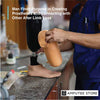Processing Grief After Limb Loss
Many people cope with limb loss by pouring their energies into various endeavors—running marathons, sailing around the world, writing books, and other incredible feats. However, it’s also important to acknowledge the other side of the coin—some go through grief and depression after limb loss. If you are going through the latter, you are not alone.

Grief vs. Depression
During the grieving process, it’s completely normal to feel anger, sadness, or a loss of self-esteem. However, there will still be pockets of happiness and moments of enjoying life.
In contrast, people with clinical depression feel these emotions most or all the time. And although people may attempt to support or comfort you, depression makes it harder to accept their help, leading to self-isolation.
Symptoms of clinical depression include lack of energy, withdrawing from social situations, losing interest in activities you once found enjoyable, trouble focusing, having no appetite, and changes in eating and sleeping habits.
Depression is a severe medical condition. If you’re suffering from depression, please seek help from a counselor, a psychiatrist, or another mental health professional.
Processing grief
The first step to processing grief after limb loss is acknowledging that it’s okay not to be okay. There’s no shame in feeling angry, frustrated, or sad. You are going through something traumatic and life-changing, so it’s important to acknowledge those feelings. As bestselling author Susan Cain says in her book, Bittersweet: How Sorrow and Longing Make Us Whole, “No matter how much your culture tells you to smile, it’s not human to simply move on.”
"No matter how much your culture tells you to smile, it's not human to simply move on."
- Susan Cain
Some people may go through a prolonged grieving process than others. You may go through several phases of grief, but others may not experience it in the same order as you. You may also find that the coping mechanisms that work for others aren’t helpful for you. Your grief is personal, so your journey will be unique.
The second step is to understand that limb loss will also lead to other losses, such as physical and emotional changes. Whether or not you use a prosthetic limb, amputation has many long-term effects. You may not be able to run or dance the same way. You may not be able to do the things you love. You may need to let go of specific activities and hobbies; however, it doesn’t mean you can’t do them forever. As many amputees have already proven, you can adapt. But you don’t need to rush the process. Take it one step and one day at a time.
The third step is understanding that your body image may never be the same. You may grapple with self-consciousness over how your body has changed. This is when you’ll need to focus on what you like about yourself that’s not limited to how you look. Work with your therapist on this aspect. You can also ask your health care team about lifestyle choices to help you feel physically and emotionally better. You’re more likely to develop a positive body image when you feel great.
You're more likely to develop a positive body image when you feel great.
Fourth, don’t repress your emotions. Instead, express them. There are many ways you can express your feelings. You can keep a journal or draw and paint. Music is also therapeutic, so go ahead and sing, dance, or play an instrument. Choose your method of expression, and don’t hold back.
In the same book, Cain wrote, “Whatever pain you can’t get rid of, make it your creative offering.” And these creative offerings—whether a book, a speech, or music—can help more people understand the pain you and other amputees go through. And with this broader understanding, we can hopefully build a better, more empathetic world.
"Whatever pain you can't get rid of, make it your creative offering."
- Susan Cain
But if you prefer more personal expressions of your feelings, don’t pressure yourself into writing the next great novel. Do what feels right for you. This is your healing journey.
Fifth, talk to someone who has been through an amputation. Sometimes simply knowing that other people are facing or have overcome the same challenges can be enough to give you hope. So, find a friend you can trust or ask your healthcare team to connect you with a certified peer visitor. Talk to them whenever you need to vent or find solutions to problems. The experience can be uplifting.
The bottom line
Take it one step and one day at a time. When things are hard, and everything feels hopeless, don’t focus on the result you want. Learn to be more present and acknowledge your emotions. Don’t be afraid of darker emotions, like anger and sadness. You are going through something life-changing, so be gentle with yourself.
But don’t bear everything alone. Find your community, a support system, or a listening ear. Having the right company can be uplifting, giving you enough strength to carry on with the journey.
You can do this.










































































